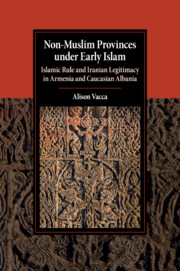 Non-Muslim Provinces under Early Islam
Non-Muslim Provinces under Early Islam Published online by Cambridge University Press: 08 September 2017
In his tenth-century History of the Arcruni House, T'ovma Arcruni complains about the ʿAbbāsid caliph Mutawakkil. The caliph “began to lift his horns in impiety to roar and butt at the four corners of the earth … for confusion and the spreading of blood were dear to him.” He “pour[ed] out the bitterness of his mortal poison” and attacked Armenia “in great folly” and “like a ferocious wild beast.” The charges leveled against the caliph here are not necessarily noteworthy in and of themselves, but for the fact that the passage is pulled nearly verbatim from Ełišē's fifth-century description of the Sasanian emperor Yazdegerd. J. Muyldermans argues that this case demonstrates the recycling of specific descriptors in medieval Armenian texts, an enduring “procédé hagiographique” by which Christians responded to persecution of the faith in a uniform way. The comparison between Ełišē's Yazdegerd and T'ovma's Mutawakkil reveals the entrenched nature of the corpus of historical works composed in Armenia. Understanding of Near Eastern texts in general is predicated on the ability of the modern historian to perceive the “multilayered narrative,” in this case, earlier histories and personalities that the medieval reader would presumably recognize.
The two passages, so similar despite the lapse of five centuries between the authors, also illustrate the way in which perceptions of power varied little in the transition from the Sasanian Empire to the Caliphate, a trend we see in descriptions of local governors and universal monarchs alike. Although substantial changes were introduced over several centuries, as neither the Sasanian nor caliphal administration remained static with set, invariable policies, a few similarities demonstrate a sustained administrative continuity and, much more commonly, the perception of continuity between the two periods. We see this not only in the brief passage discussed in Muyldermans's article, but also in T'ovma's general tendency to turn to Ełišē's depiction of the Sasanian period to color his description of caliphal rule. In his introduction to the History of the Arcruni House, R. Thomson notes the potential political message for T'ovma's audience:
there are many occasions when Thomas depicts his Muslims or contemporary Armenians with imagery taken directly from Ełishē.
To save this book to your Kindle, first ensure no-reply@cambridge.org is added to your Approved Personal Document E-mail List under your Personal Document Settings on the Manage Your Content and Devices page of your Amazon account. Then enter the ‘name’ part of your Kindle email address below. Find out more about saving to your Kindle.
Note you can select to save to either the @free.kindle.com or @kindle.com variations. ‘@free.kindle.com’ emails are free but can only be saved to your device when it is connected to wi-fi. ‘@kindle.com’ emails can be delivered even when you are not connected to wi-fi, but note that service fees apply.
Find out more about the Kindle Personal Document Service.
To save content items to your account, please confirm that you agree to abide by our usage policies. If this is the first time you use this feature, you will be asked to authorise Cambridge Core to connect with your account. Find out more about saving content to Dropbox.
To save content items to your account, please confirm that you agree to abide by our usage policies. If this is the first time you use this feature, you will be asked to authorise Cambridge Core to connect with your account. Find out more about saving content to Google Drive.